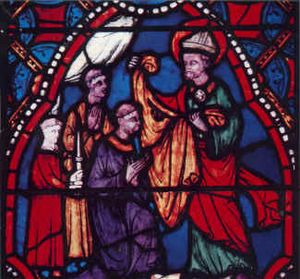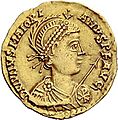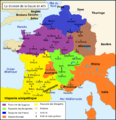Sidonius Apollinaris facts for kids
Quick facts for kids SaintSidonius Apollinaris |
|
|---|---|
 |
|
| Born | c. 430 Lugdunum, Gaul, Western Roman Empire |
| Died | c. 485 Clermont-Ferrand, Kingdom of the Visigoths |
| Venerated in | Catholic Church |
| Feast | 21 August |
| Major works | Carmina; Epistles |
Sidonius Apollinaris (born around 430 AD, died 481/490 AD) was an important figure in ancient Rome. He was a talented poet, a skilled diplomat, and later became a bishop. Sidonius came from a wealthy and powerful family in Gaul, which was part of the Western Roman Empire.
He married the daughter of Emperor Avitus. Later, Emperor Anthemius made him the Urban Prefect of Rome in 468. This was a very important job in the city. In 469, he became the Bishop of Clermont. He bravely helped defend Clermont from the Visigoths between 473 and 475. Sidonius kept his role as bishop even after the city was taken. He is honored as a saint in the Catholic Church, with his special day on August 21.
Sidonius is considered one of the most important writers from Gaul in the 400s. His letters are a great source of information about that time. He was part of a group of important Roman families in Gaul. His writings often used many references to classical Roman and biblical stories. This showed off his education and his identity as a Roman aristocrat.
Contents
Sidonius's Early Life and Family
Sidonius was born in Lugdunum, which is now the city of Lyon in France. His family had a long history of important roles in the Roman government. His father was a Prefect of Gaul under Emperor Valentinian III. A Prefect was a high-ranking official.
His grandfather, Apollinaris, was also a Prefect of Gaul around 408-409 AD. It's even possible that Sidonius was related to an earlier Apollinaris who was a Prefect under Emperor Constantine II.
Marriage and Home Life
Around 452 AD, Sidonius married a woman named Papianilla. She was the daughter of Emperor Avitus. They had a son named Apollinaris and at least two daughters, Severina and Roscia.
As part of Papianilla's dowry (a gift from her family when she married), Sidonius received a summer home. This villa was called Avitacum and was located by Lac d'Aydat, a lake. He wrote about his villa in his letters, describing it as a beautiful L-shaped house with three baths, sitting on a hill overlooking the lake.
Sidonius as a Roman Leader
Sidonius was well-connected with many important Roman families in Gaul. His letters show how wide his network of friends and contacts was. He mainly wrote to people in his home region of Auvergne, especially in Clermont and Lyon. He also had contacts in cities like Narbonne and Bordeaux. Some of his letters even reached far-off places like Ravenna, Rome, and Hispania (modern Spain).
He was known for his writing skills. In 456 AD, a bronze statue of him was placed in the libraries of Trajan's Forum in Rome. This was a huge honor, and it was the last statue ever put there.
Serving Emperors
Sidonius spent time at the court of Theodoric II, who was the king of the Visigoths, around 455 or 456 AD. He admired Theodoric and wrote about his court.
When his father-in-law, Avitus, became emperor in 455, Sidonius wrote a special poem praising him. This type of poem is called a panegyric. In 457, another emperor, Majorian, took over. Sidonius was captured, but Majorian respected his knowledge. Sidonius then wrote a panegyric for Majorian, which earned him a statue in Rome and a special title.
In 468, Emperor Anthemius appointed Sidonius as the Urban Prefect of Rome. He held this important position until 469. Sidonius believed this was a reward for his writing, especially the poem he wrote for Anthemius. However, it was also likely a way for Anthemius to gain support from the Roman leaders in Gaul. After this, Anthemius also made him a Patrician and a Senator.
Sidonius as a Bishop
In 469, Sidonius was chosen to become the Bishop of Clermont. He didn't write much about this, and it seems he wasn't eager for the role. However, he became a dedicated bishop.
Gregory of Tours, a historian, wrote that Sidonius could lead Mass from memory and give speeches without preparation. He praised church leaders and those who wrote about religious topics. When he became a bishop, Sidonius publicly said he would stop writing pagan poetry, as it didn't fit with a religious life. But he continued to write and share poems privately with friends.
Defending Clermont from the Visigoths
From 473 to 475, Sidonius and his brother-in-law, Ecdicus, bravely led the defense of Clermont. The city was attacked every year by the Visigoths under their king, Euric. Sidonius compared this fight to an ancient war where a city was defended against a powerful enemy.
When Clermont was finally conquered, Sidonius was imprisoned and sent away. But King Euric allowed him to return and continue his work as bishop in 476 or 477. This happened after one of Euric's advisors, Leo, spoke up for him. Sidonius kept in touch with Euric's court after that.
Euric favored a different Christian belief called Arianism over Catholicism. Sidonius worked to support Catholic clergy throughout Gaul. He helped them with legal issues and gave recommendations.
Sidonius's Views on the Goths
Sidonius understood that some cooperation with Euric's court was needed. This helped keep the Roman leaders in Gaul united. However, he didn't like the Goths. He once wrote to a senator, "You avoid barbarians because they have a bad reputation; I avoid them, even when they have a good one."
He made fun of Euric's court, which was known for trying to be very cultured. Sidonius felt that the Visigothic conquest had turned the social order upside down. He believed that uneducated people were now in charge of the educated. He also had legal problems with a Gothic noble who took much of his mother-in-law's land. He also disagreed with a man named Seronatus, who he thought was helping the Goths too much.
Sidonius showed his dislike for Euric by starting his collection of letters with a letter praising Theoderic II. Euric had actually murdered Theoderic II to become king.
Sidonius was alive in 481 but had died by 490. His successor as bishop died in 490. Sidonius died on August 21 or 23. After his death, he was honored as a saint.
Sidonius's Family After Him
Sidonius's family history has been studied for many generations. His son, Apollinaris, led a military unit from Auvergne in a big battle in 507. In this battle, the Goths were defeated by the Franks. Apollinaris also served as Bishop of Clermont for four months before he died.
Sidonius's grandson, Arcadius, made a mistake when he heard a rumor that the Frankish king had died. He betrayed Clermont to another king, but then abandoned his family when the first king reappeared.
Sidonius's Writings
Sidonius's writings are very important for understanding his time. He wrote two main types of works: Carmina (poems) and Letters.
Carmina: His Poems
A collection of twenty-four poems by Sidonius still exists. These poems were written for different occasions. They include panegyrics, which are poems praising different emperors. These poems help us learn about important political events of the time. Sidonius often looked back at Rome's past successes and glories. He used them as examples for the rulers of his own time. He showed how much Rome had declined but also suggested that it could become strong again.
In his poems for Emperors Avitus and Majorian, Sidonius reviewed past emperors. He said that only those who earned their title through virtue, especially military strength, deserved praise. This was a challenge to the new emperors. Other poems covered different topics. For example, one poem describes a painting of a war on the wall of a friend's villa.
Letters: His Correspondence
Nine books of Sidonius's Letters have been saved. They contain 147 letters sent to 117 different people. Sidonius worked on this collection for a long time. He published some in the early 470s and finished the final version around 477.
His letters were dedicated to Constantius, a priest in Lyon. Constantius was a personal friend and helped edit the collection. Sidonius apologized to a high-ranking official for putting a priest first. He explained that even a minor priest should be honored more than the greatest non-religious people.
Sidonius's Latin writing style was highly praised during his lifetime. A writer named Claudianus Mamertus called him the "resuscitator of ancient eloquence." However, some modern scholars find his style very complex and difficult to understand. Sidonius intentionally made his writing elaborate and learned. He used many references to classical and biblical stories. This style was meant for a small group of educated people. For Sidonius, knowing classical Latin authors was key to education and showed an aristocrat's social standing. He believed that the difference between educated and uneducated people was like the difference between humans and animals.
Despite their complex style, Sidonius's letters are a valuable source of information about life in his time. Many studies have used them to understand the social connections of educated people in 4th-century Gaul. Sidonius often modeled his letters on those of earlier writers, like Pliny the Younger. He presented Rome as a perfect society. Some historians believe this picture of continuity was actually his way of responding to the rapid changes happening in Gaul. Through his writing, Sidonius tried to strengthen Roman identity and culture. He also aimed to support the position of the Roman aristocracy and the church.
One of Sidonius's letters is especially interesting. It was sent to Riothamus, who was called "King of the Brittones" around 470 AD. This letter provides evidence that a king or military leader connected to Britain lived around the time of the legendary King Arthur.
Images for kids
-
A coin showing Majorian (ruled 457-461).
-
Map of Gaul in 475, before Euric's conquest of Clermont. Yellow: Visigothic kingdom; Orange: Western Roman Empire; Green: Burgundian kingdom.
See also
 In Spanish: Sidonio Apolinar para niños
In Spanish: Sidonio Apolinar para niños







